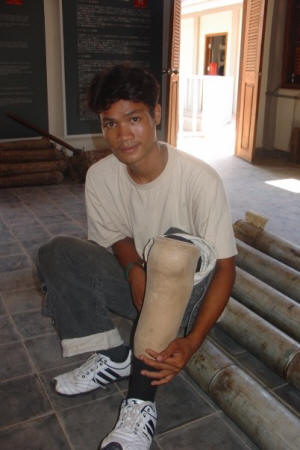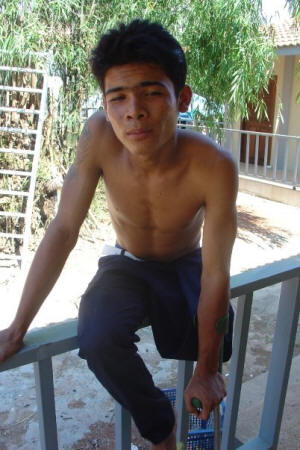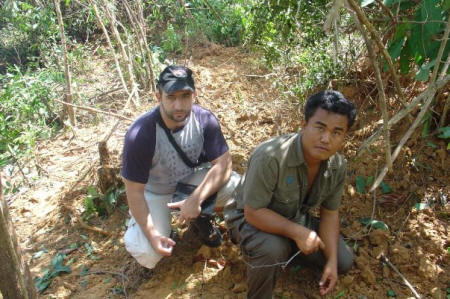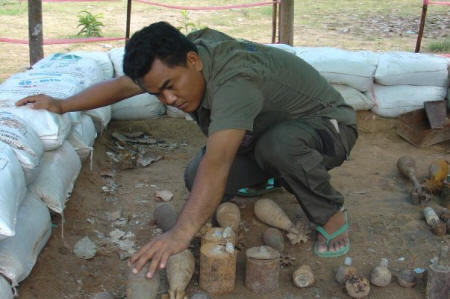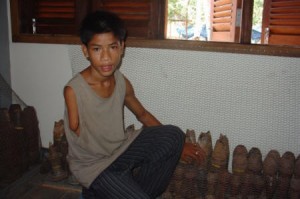
- It costs $3 to make a mine.
- A child can lay mines.
- It cost $500 to remove a mine from the earth.
- Children step on mines.
- Mines cost children their limbs.
The tiny room was filled with bombs, rockets, bullets, and of course, land mines. “This is one is a Vietnamese mine,” said Boreath, holding up the now disarmed weapon of destruction. He was holding it in his left hand, because his right arm was missing, from the shoulder down. Boreath pointed at what looked like a bear trap. “If you step on this one, and no one come to help you, two hours and all blood go from your body, and you die.” It was not hard to imagine the cruelty of those massive steel jaws slamming shut on your leg. There were some steel jacks, with spikes approximately three inches long. “They throw these everywhere on the ground. When you step on them, they get stuck in your foot.”
Boreath explained nearly every weapon from the display. “This one is American, we call bouncing betty. Step on this one and it jumps up and blows your leg off. These are machine gun bullets. These bombs fall from the sky. This one comes from Russia. This mine is a Chinese copy of an American mine.” Boreath was an expert on explosives and the remnants of a war he could not remember, but to which he still fell victim.
Fourteen year old Boreath is a happy, polite, clean cut Khmer kid who likes playing sports and spending time with his adopted family. Talking to him for just a few minutes you would realize that he is exceptionally bright and that he speaks excellent English. If he wasn’t missing an arm, he could be any child from a privileged Phnom Penh family, who can afford to send their kids to an expensive international school. Looking into his bright, smiling eyes, it is hard to imagine that he is from a poor family, with six children, born in a remote village, where there wasn’t even a school.
“My village was near the Thai border,” explained Boreath. The five provinces on Cambodia’s Thai border are some of the most heavily mined regions in Asia. “Seven years ago, I was playing, digging in the woods, when I hit the mortar bomb.”
The fact that Boreath was playing in the woods nearly two decades after the end of the war did not keep him safe. Unexploded bombs and mines can remain active for up to 150 years.
“Near my village there was no public hospital, only a private one and they didn’t want to help me because my family has no money. So, we went to the military aid station. I stayed there for one month.”
Boreath’s story is all too common in Cambodia. The landmines are a tremendous social problem, as people, particularly farmers, are frequently injured by them. But Boreath’s story illustrates other issues facing the average Khmer family, namely the lack of money and lack of access to competent medical care.
“My family not have school, not have money, not have anything. Three years ago, Aki Ra came to the Thai border to remove mines. He asked me if I wanted to come to Siem Reap and live with his family. And my family agreed.”
Now, Boreath has a roof over his head, three meals per day, a school to go to, plus supplemental English and Japanese lessons taught by volunteers. He also has about twenty new brothers and sisters who live with him, all of whom are landmine victims.
The man who made all of this possible is Aki Ra.
Aki Ra is one of the great heroes of modern Cambodia. Born a Khmer Rouge jungle fighter, Aki Ra spent most of his youth putting mines in the ground. He was later forced into the Vietnamese army, and was employed to put mines in the ground, this time, fighting against the Khmer Rouge. Aki Ra eventually had enough of killing, came of out of the jungle, and surrendered. He served with the UN peace keepers, doing de-mining work. Later, he opened the land mine museum, where he displayed unexploded ordinance, so that foreigners could learn the horrors of the Cambodian genocide. He and his wife also opened his home to landmine victims, raising more than twenty of them as his own children. Aki Ra pays for their food, education, and medical care. Through the support of an NGO, called Handicapped International, he is also able to provide his children with prosthetic limbs.
Aki Ra used to have his family living at the Aki Ra Mine Action headquarters, which was at his wooden house and compound near the river. The building wear I met Boreath was the new land mine museum, thirty kilometers outside of Siem Reap city. Although they have already had their grand opening, Stuart Cochlin, a volunteer architect, is helping Aki Ra complete the new center.
“The museum is already opened, but we are still finishing the rest of the complex.” Explained Cochlin. “There will be a school, a clinic, dormitories and a shower block for the kids. There will be a house for Aki Ra and his family, and dormitories for the volunteer teachers.”
“The way it stands now, the kids have to walk seven kilometers to primary school.” Said Cochlin. “The high school is even further away.”
Seven kilometers is a long distance for anyone to walk, but particularly difficult for children who are missing a leg. The rainy season must be especially uncomfortable to undertake such a lengthy hike.
“The school is extremely important.” Said Cochlin, “Many of the kids get teased at school. So, they lost interest in going. The rules in the new house, however, will be, go to school or find somewhere else to live.”
The clinic is also important. On the way to the museum we passed the children’s hospital where hundreds of people stood in line, every day, just to see a doctor.
Construction crews were hard at work on the new center, and hope to have it done in a few months. In the mean time, the kids said they are sleeping in hammocks.
A seventeen year old boy, named Chet, told me he had been living with Aki Ra for three years. In spite of having lost a leg, Chet told me. “I can walk well and play football, but I cannot jump. And, my leg hurts often.”
Chet was an orphan, living on the streets of Phnom Penh, shining shoes. About five years ago, when he was twelve, a man offered Chet a job, cutting trees in Battambong.
“I was walking between the fields and stepped on a mine.”
Once again, there was no hospital. The local people stopped the bleeding by wrapping the wound with Krama, traditional Khmer scarves. After Chet recovered, his employer dropped him back on the streets of Phnom Penh, where he began shining shoes again.
“I didn’t have a plastic leg then. I had to use crutches.” Said Chet, holding out his hands so I could see the permanent scars the crutches had left.
“I didn’t have a house or a family. I slept on the streets. I didn’t go to school. Aki Ra saw me when he came to Phnom Penh, and he asked if I wanted to go live at his house.” Chet smiled. “Now, I go to school, play kick ball, and work as a guide. I also play music. I love the keyboard. We all learned English at the old museum from the volunteer teachers. And here, we have the other children, same as family.”
I asked Chet if he walked the seven kilometers to school every day.
“Yes, I walk. I cannot have a driver.”
Another boy was missing a leg told us that although he was eighteen, he was only in the seventh grade. Going to live with Aki Ra was the only hope any of these children ever had of getting an education, learning English, or in some cases, having a family. When the center is completed, they will be living better than 90% of Khmer kids.
Aki Ra and the Land Mine Relief Fund NGO are doing great things to help these kids. Richard Fitoussi, a war photographer from Canada, is the man most responsible for the existence of the NGO and much of the money which has come in. But once again, the very fact that such an NGO is needed suggests that the local government just doesn’t care about the people.
A tourist lady from England barged into the museum, and tore past all of the displays, without even glancing at them.
“Do you speak English?” She asked me, having given up on the child amputee who was guiding her.
I was a little embarrassed to admit that I did.
“Where is the portrait of Princes Diana?” she asked. “Diana did a lot for these people, I came all the way from England to see her portrait. But no one even seems to know her name.”
It took me a minute, but then I remembered that Princes Diana had been instrumental in founding the HALO Trust, a de-mining NGO. Sadly, I had to tell the British lady that as far as I knew, there was no portrait of the princes in the museum.
The woman turned, brushed past the bombs and wounded children, hoped back in her tuk-tuk and left.
Perhaps the only thing more shocking than the lack of interest shown be the local government is the lack of interest shown by the developed world.
It appears that the de-mining efforts of the Cambodian government are focused on de-mining the development areas and tourist locations, but the farms, which cover the vast majority of the Khmer landscape, are the lowest priority.
Two years ago, while doing stories in Siem Reap, I stopped in, unannounced, at the old landmine museum, to interview Aki Ra.
Since then, things have obviously changed for Aki Ra. For three weeks prior to coming to Siem Reap, I sent email requesting an interview. “There are three documentary film makers in town right now, all of whom want to do interviews with Aki Ra,” a spokesman for the Land Mine relief Fund told me. They finally agreed to let me have an interview with Aki Ra’s second in command, but couldn’t guarantee that I would get to see the man himself. As I pulled up to the museum, I saw Aki Ra in green army fatigues, getting into a jeep. I ran over, and asked for the interview.
“I am sorry.” He said. “I have no time. I am on my way to detonate some mines.”
“Can I come with?” I asked.
He looked me up and down, eventually saying, “Okay, get in.”
In the vehicle were a Khmer driver, a Japanese de-miner, and a Japanese kid who claimed to be a tourist, but behaved like a journalist. Not to promote racial stereotypes, but both of the Japanese had better cameras than me. I, however, had a digital voice recorder. The Japanese did not have a digital voice recorder. Great success!
As the vehicle made its bumpy way to a point out near the airport, Aki Ra explained the operation.
“I now have 150 soldiers working for me, who I trained. We collect unexploded ordnance all month and store it in a safe location.”
By a safe location, he meant a pit twenty meters behind the tents where the soldiers slept. But he was right. The location was safe. No one was going to be able to steal those mines.
“Once or twice a month, when we have enough pieces, we carry them to another safe location and detonate them.”
“Sometimes we have a hundred, sometimes more.”
I am not a mine expert, but the thought of digging up a mine, moving it, storing it, and moving it again, sounded terribly dangerous.
“No, we are careful, to hold them upright when we move them and not jiggle them from side to side.”
If he had only told me that at the beginning I would have been glad to help.
Aki Ra explained that the airport location had been heavily mined during fighting between the Khmer Rouge and Vietnamese, in 1985. “Many of the mines are American, taken from the Lon Nol Republican forces or from the Americans in Vietnam.”
A group of soldiers were waiting for us at the camp, near the disposal location. The camp was nothing like the well-appointed and organized camps of American GIs. The Cambodian soldiers slept in hammocks. Most were out of uniform, a few were wearing sarongs. Some even had their families with them. Just a few meters away was the pit where the mines and munitions were stowed until they are moved to the detonation site.
The pit held an array of unexploded ordnance, mortars, mines, bombs, claymores, Rocket Propelled Grenades (RPG), and baseball grenade and pineapple grenades.
“The M-79 (a grenade fired from an assault rifle) is the most dangerous.” Pronounced Aki Ra.
When I asked a question about mines, Aki Ra was quick to answer.
“We don’t use the word mine. The government will get angry, because I don’t have a de-mining license.”
For years, the government and a number of other organizations had been trying to shut Aki Ra down. The charges against Aki Ra were often non-specific. The most common ones were that he was stock piling munitions, or that he was de-mining without a license.
Would either of these charges be a good enough reason to take the prosthetic limbs away from the orphans and toss them back on the streets?
Stuart explained that the new land mine museum is part of an NGO, called the Land Mine Relief Fund. “This is a real, legal NGO, with transparency and proper licensing and papers. Now, that we have the NGO, all of Aki Ra’s demining efforts are his private affair, outside of the NGO. We have nothing to do with that.”
This separation should protect the children and the museum. As for Aki Ra as an individual, steps are being taken there as well.
“When the disarmed munitions were moved to the new museum, all the pieces were checked, numbered, and tagged by an expert NGO. And now, no one can say anything.” Said Stuart.
This should alleviate the issue of stockpiling munitions. But what about the second charge, demining without a license? Aki Ra has applied for a demining license, but has not been approved. Meanwhile, he is often asked to speak at conferences around the globe, as he is recognized as a leading authority on landmines. If the world accepts that he is an expert, why can’t the local government and demining NGOs? One theory is that the reason is purely financial.
Five years ago, it was estimated that there were 6 million mines in Cambodia. Aki Ra has been known to take as many as 36 mines out of the Earth in an hour. He is personally credited with having removed tens of thousands of mines. The average cost for an aid organization to remove a mine is $500. Said another way, someone earns $500 for every mine that comes out of the ground. Aki Ra demines for free. Every mine he takes out of the earth is denying $500 income to someone. If there were no Aki Ra, the people who have a monopoly on the demining business could be looking at an income of $3,000,000,000 (6 million mines times $500).
No one has come out and admitted that human suffering is a big business, but NGOs have justified shutting Aki Ra down on the grounds that “he will get someone killed.”
Aki Ra has removed tens of thousands of mines from the ground. By doing so, he has saved countless lives. Even if he blew himself up tomorrow, why should the NGOs care? He would stop demining if he were dead.
Professional demining teams normally remove one mine per day. Aki Ra, working alone, with a stick and a knife, makes the big boys, with their expensive equipment look bad. No one wants to look bad.
One final, profit related motive that people may have for wanting to close Aki Ra down is that he is successful.
“People don’t like you when you are successful,” said Stuart.
Cambodian society is prone to what Pol Pot and Mao called “tall poppy syndrome.” In a field of poppies, the tall poppy, the one who stands up or stands out, gets his head cut off.
Aki Ra’s landmine museum may be seen as a direct competition to the government owned war museum in Siem Reap, a collection of rotted out and rusting mix and match military paraphernalia dating back to the French colonial war. All of the pieces lie exposed to the elements, with little or no information available. Aside from the fact that the war museum is easily the least impressive tourist attraction I have ever seen, apart from the museum of barnyard oddities, another reason to give it a miss is that the money is not going to help orphans or disabled people. The rumor is that a high ranking general gets the money from the museum. Rumors aside, Aki Ra now has a legitimate NGO, which is helping people. The war museum is only an attraction. When I asked the guide at the war museum if they were associated with an NGO, he was quick to point out, the donation box. “You can put money in there for the Cambodian Red Cross.”
Maybe I had judged them too harshly, clearly their humanitarian activities rival even Aki Ra’s.
Although the government still does not officially support Aki Ra, he has some support from the army.
“I have fifty men working for me here. Another group works over there. They destroyed mines earlier this morning. I call the two groups Khmer Rouge team and Vietnamese team.”
I didn’t envy the soldiers working in the hot Cambodian sun. The enlisted men wore uniforms of coarse, horrible cotton, which didn’t breath. The rich officers wore uniforms of horrible polyester, which didn’t breath.
“The soldiers only earn $30 a month, so I have to buy food for them.”
At the detonation site, more than one hundred pieces of explosive ordnance were piled in a hole, about a meter and half deep.
“We don’t have det-cord, so I make myself. We use a car battery, plus and minus, and at the other end is a detonator from a Chinese Bouncing Betty mine.”
The hole full of explosives was filled in. Then we hiked twenty meters up a hill back to the road. I thought we would crouch behind the vehicles like in a war movie.
“We have to go far away because of the fragments.” Said Aki Ra, getting into the vehicle. Thinking of all of those scary explosives I wanted to suggest we go even further away.
The Japanese guys set up their cameras to fire from remote, so they could get a video of the explosion. I, however, couldn’t risk my camera. So, I took it with me, to our safe place about a kilometer away. Now the Japanese had a lead on me, two to one.
After the explosion, the smell of cordite was overwhelming. “I love the smell of cordite in the morning.”
Although the hole had been filled in before the detonation, all of the dirt had been blown out, and the hole was now a smoldering crater, about two meters wide.
Back at Aki Ra’s old house, he suddenly produced four mines which he and the Japanese guy would disarm. After removing the detonators, they had to cut off the outer casing. This they did with a hatchet. When I tried to take a photo, Aki Ra warned me, “No photos. This is not legal because I am not wearing a helmet.”
I didn’t want to tell anyone their business, but if you are hitting a mine with a hatchet, a helmet probably isn’t going to save you.
Then they used a nail and a hammer to chip of the bottom plate. They sprayed the housing with a lot of WD-40 spray oil to ensure it slipped off.
Next, they put the mine in a vice and tightened it till their muscles bulged. When they began banging the mine with a hammer, I remembered another appointment, and made my exit.
If you visit the Land Mine Museum you can donate money to the NGO and help keep the children fed and in school. You can also make donations to the Land Mine Relief Fund or contact them by email: info@cambodialandminemuseum.org.


